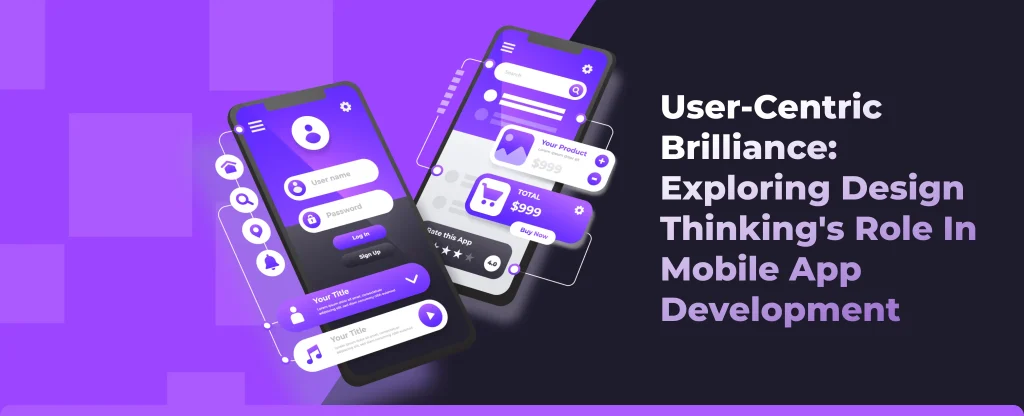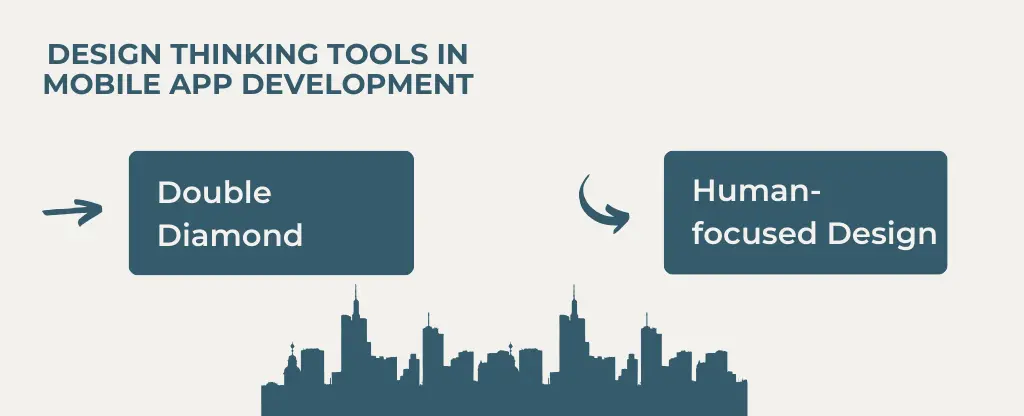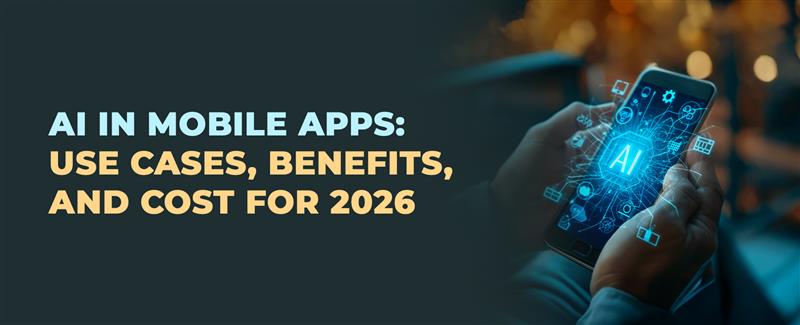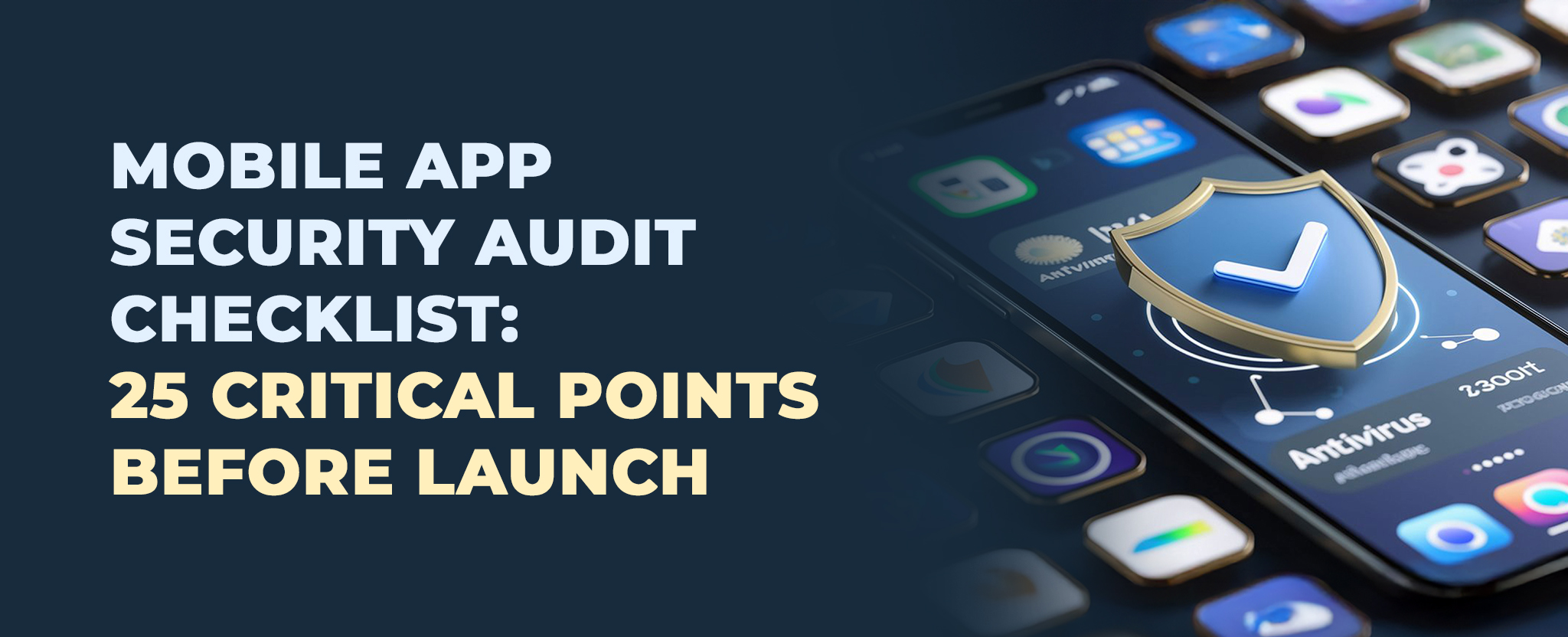User-Centric Brilliance: Exploring Design Thinking’s Role in Mobile App Development
23 Nov 23 


The mobile app development process can be complicated because many factors must be considered. Good planning is essential for developing an excellent mobile application. Setting targets, analyzing customer issues or difficulties, and creating feasible options are all made possible by design thinking processes. You may determine how valuable your ideas are to customers through this process.
Designing a mobile application or digital solution is the most critical phase. The most crucial steps to a solution’s success are developing a tool with features and a design that adapts to the demands of a business. For this purpose, as a leading mobile app development company, we will discuss the definition of design thinking, its stages, and its application to mobile application development.
New tools, platforms, and approaches have been developed recently to streamline procedures and boost their efficacy, partly due to the rise in the creation of software solutions and mobile apps.
Design thinking also aids in the elimination of any UI/UX design mistakes to guarantee that customers receive the most incredible experience possible. This method necessitates a thorough analysis and investigation of customer concerns to generate a product that engages with users. We will talk about design thinking and its benefits in this blog entry.
Design Thinking: What Does It Mean?
The design thinking strategy entails comprehending customer requirements, recognizing complicated issues, and developing practical remedies. It is also possible to solve unidentified problems through this process. Many industries use the design thinking methodology, including IT, research, architecture, mobile app development, and more.
Design thinking is a human-centered process. In other words, it examines how users interact with a good or service. Design thinking looks at the ways individuals engage with mobile apps and works to fix any problems to enhance the user experience. This can be an ongoing procedure to continuously improve your product and give your customers the most significant possible experience.
Two Tools for Design Thinking in Mobile App Development
Choosing which of the various resources accessible to create amazing apps to employ can be challenging for design teams. These resources are frequently employed during the app development process’s ideation phase.
The top two design thinking resources for creating apps are as follows:

1. Double Diamond
The British Design Council introduced the double diamond pattern, a twofold diverge-converge pattern, in 2005. Finding, defining, creating, and delivering ideas is its aim.
It comprises two parts:
- A first diamond is used to identify the correct issue.
- A second diamond is used to identify the correct solution.
Find and identify the phases of the first diamond, then create and provide the stages for the second diamond.
App design teams generate multiple thoughts according to the diamond they’re in throughout divergence. If it’s the first diamond, they will talk about various solutions to the issue. If it’s the second diamond, they talk about potential solutions according to the point of first discovering the problem.
App design teams attempt to separate concepts from their corresponding divergence stages throughout convergence. They try to reduce the issue to a straightforward notion for the first diamond. Comparably, they look for a particular remedy to the problem throughout the second diamond.
Recurring patterns of divergence and convergence can be used to identify the correct problem an app is attempting to solve and how to solve it. Although it may appear chaotic, there is a great deal of structure in the process using a systematic strategy.
Time management is a crucial factor that must be considered for this tool to be used successfully. Determining the point at which divergence or convergence stops can be challenging for design teams. Setting a time frame can help prevent this.
2. Human-focused Design
Going with the double diamond tool can occasionally cause an app design team to become overly preoccupied with the procedure instead of the real problems.
Teammates must adhere to the rules of human-centered design to prevent this. The user-centered method assists groups in focusing on the task at hand, creating solutions that benefit people, and briefly putting them together.
The best way to use double diamonds is to combine them with different phases of human-focused design. These phases are now a crucial distinguishing feature of the design thinking methodology. They must be applied circularly and continuously to enable ongoing enhancements.
Human-centred design divides design thinking into the following phases:
- Observation
Find and watch prospective users of the app to learn about their requirements, goals, and areas of demand.
- Idea creation (ideation)
After the design needs of the app are determined, this step entails coming up with possible solutions.
- Prototyping
It must be tested to ascertain whether an app idea is practical and possible. MVP can be used to accomplish this. Consider the results of the first two activities when you construct one.
- Testing
An MVP for an app can be evaluated when it’s available. Discovering the right audience to test it with and determining the appropriate metrics to monitor present challenges. Testing and prototyping are done during both diamonds to ensure that the issue and its solution are fully comprehended.
The procedure occasionally calls for an unpredictable alternation between the various tasks. This process is called iteration, frequently requiring several to perfect it. If that’s the case, don’t get upset. Regarding the double diamond, it’s advisable to set a time frame.
Stages of Design Thinking
Designers can innovate methodically by using the design thinking process. It is inventive as well as demanding. Designers can solve particular design-related issues with the creative solutions they develop. App development is one area where design thinking excels; it is typically used as a problem-solving and problem-identifying tool.
The app’s design team and developers must initially correctly determine the issue as part of the design process rather than making quick judgments and creating remedies immediately. This, in turn, necessitates knowing the needs of the application’s users and how to assist them in reaching their objectives.
Enterprise mobile app development teams can be sure they are tackling the proper challenge, not adequately ignoring something that appears to be an issue but needs to be done.
Graphic design also plays a crucial role in this process, ensuring that the visual elements align with user expectations and enhance usability.
Therefore, let’s move on to the five significant stages of the design thinking process.

1. Empathize
The first step is to see and learn how your intended customer base uses a product or service. Gain insight into your users’ problems by developing empathy for them. This method can help identify issues that users might need to be aware of. Understanding the demands of your target market enables you to investigate their problems and develop approaches thoroughly.
2. Define
In the initial phase, you learn about the discomfort experiences of your consumers and develop empathy for them. You’ll require that data to define an issue you are attempting to address in the following phase.
When creating a mobile app, the first question you should ask yourself is: What solution are you attempting to address? You can also consider what sets you apart from your rivals and the solutions currently available.
You may additionally schedule the functions and design of the application according to this issue. The remedy you are attempting to provide comprises all the features in your app. It assists you in creating excellent user designs.
3. Ideation
Creating solutions for the issue you’ve identified is part of this step. It is possible to have group discussions with individuals who bring a range of specializations that will benefit your project. When different team members work together on the project, they contribute their unique inventiveness and original ideas.
Here, the emphasis should be on formulating novel concepts contributing to the problem’s solution. A few thoughts and ideas are necessary to proceed to the next stage.
4. Prototype
You will turn your concepts into feasible options at this point. Here, the main goal is to develop a version of your product that follows your ideas. For instance, you can begin the mobile app development process by designing wireframes to see how your app will appear visually.
You may use this to examine how the function would improve the user’s knowledge. Next, you can create an MVP or minimal viable product, which consists of just the features required to test the product on the market.
Prototypes allow you to test whether or not your ideas will be beneficial to the end consumer. You can develop new concepts and include them in your prototype if you discover that some of your original ones could be more realistic.
5. Testing
You can test the prototype in the market once you’ve finished it. This testing phase aims to watch how your customer uses your product. You can get their opinions about your product.
The process of design thinking is nonlinear and continuous. You must return to any earlier phases to thrive after this point. When it comes to a mobile application, you may need to modify its functionality or visual components. You should return to the prototype phase to make the required adjustments.
Testing is ideal for testing your product by releasing it on a small scale. Try it out before investing time and resources in producing the final edition of the product. In this manner, you can incorporate customer input into the final version and make it beneficial for your final consumers.
What Makes Design Thinking So Essential?
Using design thinking techniques in your mobile app development practices can help you make a successful app. Design thinking can assist you with the following:
1. More Productive
Testing the idea or product is the primary goal of design thinking. To verify your mobile app, you can make wireframes or prototypes. Testing can assist you in finding any problems with your product and adding new concepts to improve it. As you refine your product during the testing phase, you maintain time and money; the result is what you require.
2. Teamwork
A variety of team members contribute to this process. When team members work together, you can access a variety of knowledge that can assist you in developing solutions that are better tailored to those who are your audience.
3. Provide Creative Answers
Using design thinking, you can identify previously unnoticed pain points. An extensive investigation and examination of your users can assist you in determining the different difficulties they might encounter. You can also ascertain the viability of your solutions with design thinking. An iterative process enables you to generate creative solutions and enhance your product.
4. Resolve Customer Concerns
As was mentioned, design thinking is a human-centred methodology. You may find issues that your target clients might be facing by investigating the customers you target. For instance, difficult navigation may deter users from using your app. Once this issue is recognized, you can develop remedies that improve the user experience.
UX and UI are crucial elements of your mobile app that help create a positive user experience. The design thinking process has a significant role in determining the effectiveness of the UI/UX design process. Design thinking can assist you in identifying the issues that your users are facing and in developing creative solutions.
Final Thoughts
Multiple sectors apply design thinking techniques. It is helpful during the mobile app development process since design and user experience are crucial to the app’s accomplishment. You can create a mobile application that appeals to your intended audience using design thinking.
It makes you more resource and time-efficient. Using prototypes and testing, you can make changes and improvements to your product before a complete release. You remove or enhance any concepts or characteristics of the product that are incompatible with your solution.
This procedure guarantees that the product you produce meets the needs of your target market. Customers will more likely interact with your app if it offers an intuitive interface. Sales, brand loyalty, and ROI all increase as a result. Mobile app development impacts sales; therefore, branding and business growth are established.
Generally speaking, it doesn’t matter what tools or design techniques are employed; what matters is that the app’s design team knows the end goal is to create a compelling user journey. The best option is to find an established mobile app development company like Mindster. Mindster can offer cutting-edge UI/UX design services for creating apps of outstanding quality. If you are seeking an expert, hire the best mobile app developers from us.
- Agentic AI1
- Android Development3
- Artificial Intelligence33
- Classified App3
- Custom App Development5
- Digital Transformation12
- Doctor Appointment Booking App14
- Dropshipping1
- Ecommerce Apps40
- Education Apps2
- Fintech-Apps37
- Fitness App4
- Flutter4
- Flutter Apps20
- Food Delivery App5
- Grocery App Development1
- Grocery Apps3
- Health Care10
- IoT2
- Loyalty Programs9
- Matrimony Apps1
- Microsoft1
- Mobile App Maintenance2
- Mobile Apps128
- Product Engineering6
- Progressive Web Apps1
- React Native Apps2
- Saas Application2
- Shopify9
- Software Development3
- Taxi Booking Apps7
- Truck Booking App5
- UI UX Design8
- Uncategorized6
- Web App Development1



















Comments